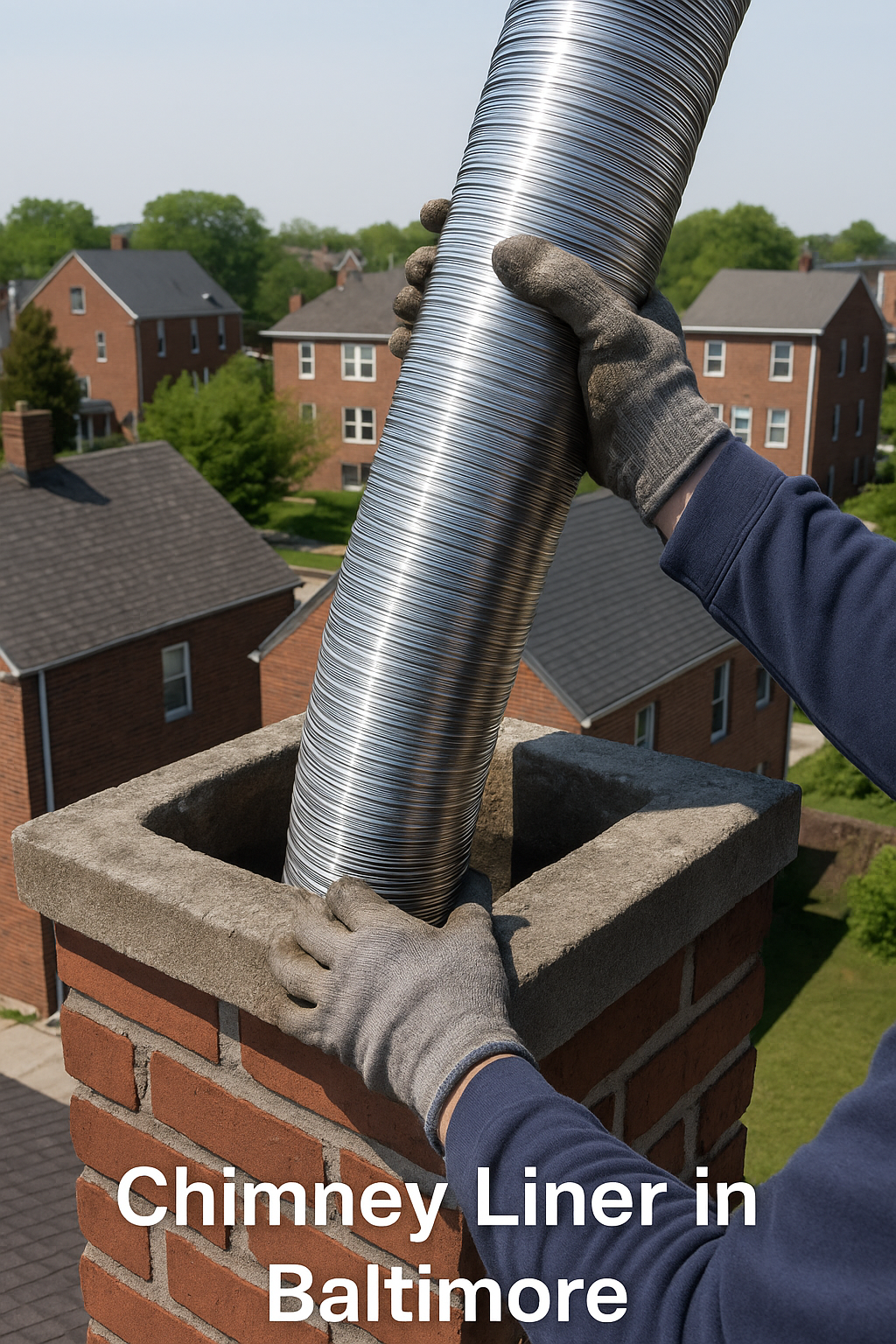Chimney Liner in Baltimore, Is Your Liner Damaged and Dangerous?

Let’s be honest most homeowners in Baltimore don’t spend a lot of time thinking about what’s inside their chimney. As long as the fireplace works and smoke goes out instead of in, things feel fine, right? But buried inside that brick tower is a piece of your home that quietly does some very heavy lifting: the chimney liner.
This often overlooked component could be the very thing standing between your cozy living room and a serious fire hazard. In this article, we’ll unpack what a chimney liner does, how to know if yours is failing, and why it’s especially important in older homes especially when it comes to maintaining a safe and efficient chimney liner in Baltimore.
So, What Exactly Is a Chimney Liner?
If you’ve never seen one before, a chimney liner is a layer (usually made of clay, metal, or cast-in-place concrete) that lines the inside of your chimney flue. You won’t notice it unless you’re having repairs done, but its job is far from invisible.
Here’s what a chimney liner does:
- Protects your home by containing heat and gases
- Improves efficiency by guiding smoke upward more smoothly
- Prevents buildup of creosote and soot
- Protects chimney walls from corrosion or structural damage
Think of it like the insulation in your walls it’s hidden, but essential to how your home runs safely.
Why It Matters in Baltimore Homes
Baltimore is full of older homes with plenty of charm and aging chimneys. Many of these were built before modern safety standards required chimney liners. Some still have cracked clay liners, while others might not have any liner at all.
Here’s why that matters:
- Older chimneys are more likely to leak carbon monoxide
- Crumbling masonry can lead to smoke and heat seeping into your walls
- A damaged liner increases the risk of chimney fires especially when burning wood
If your home is more than 30 years old and hasn’t had a chimney inspection in a while, it’s worth getting your liner checked.
Signs Your Chimney Liner Needs Help
Just because your fire lights up doesn’t mean everything’s okay. Here are some telltale signs your chimney liner in Baltimore might need repair or replacement:
1. Pieces of Tile or Debris in the Fireplace
This is usually the first visible sign. It means your clay liner is cracking or deteriorating.
2. Persistent Smoke Smells
If you smell smoke even when your fireplace isn’t in use, it could mean gases are leaking through damaged liner areas into your home.
3. Difficulty Starting Fires or Poor Draft
This could mean the liner is clogged, broken, or misaligned, making it harder for smoke to exit.
4. Stains or Moisture on Chimney Walls
Damaged liners can let moisture seep into the structure, leading to discoloration or mold.
“A chimney liner may not be something you see every day, but you’ll definitely notice when it stops doing its job.”
Certified Chimney Sweep, Baltimore
Types of Chimney Liners & Their Features
If you’re considering a new liner, here’s a quick breakdown of what’s out there:
| Type of Liner | Material | Best For | Lifespan |
| Clay Tile | Terracotta/clay | Traditional fireplaces | 15–25 years |
| Stainless Steel | Flexible/rigid | Gas, wood, and pellet appliances | 20–30 years |
| Cast-in-Place Concrete | Cement-based | Re-lining old or deteriorated flues | 30+ years |
Key Features to Look For:
- UL-listed or code-compliant
- Compatible with your fuel type
- Properly sized for your chimney
- Corrosion- and heat-resistant materials
Cost of Chimney Liner Replacement in Baltimore
Let’s talk numbers because this isn’t a $50 fix, but it’s a critical investment.
| Service | Estimated Cost |
| Basic chimney inspection | $100 – $200 |
| Stainless steel liner (installed) | $1,800 – $3,500 |
| Clay liner replacement | $2,000 – $4,000 |
| Cast-in-place liner | $3,500 – $6,000+ |
| Annual maintenance (optional) | $100 – $300 |
Pro tip: Many homeowners’ insurance policies require a safe chimney system to maintain coverage so upgrading your liner might also protect your wallet.
Safety First: Why Chimney Liners Matter So Much
Still wondering if you really need to care? Here’s why chimney liners should never be optional:
- They protect your walls from catching fire.
Heat from an unlined or damaged chimney can reach combustible materials inside your walls in just a few minutes. - They prevent carbon monoxide leaks.
A good liner keeps harmful gases headed where they belong outside. - They improve airflow and reduce creosote.
That’s important because creosote buildup is the #1 cause of chimney fires in the U.S.
Especially in Baltimore’s older brick homes, where original chimneys may have seen decades of wear, a liner can literally be the difference between safety and disaster.
Final Thoughts: Check It Before You Burn It
Your chimney liner might be hidden, but it shouldn’t be forgotten.
If you own a home in Baltimore and can’t remember the last time your chimney was inspected, don’t put it off. A quick camera inspection by a local pro can reveal cracks, damage, or missing parts that aren’t visible from the outside.
Whether you need repairs, a full replacement, or just peace of mind, taking care of your chimney liner in Baltimore is one of the smartest safety moves you can make for your home and family.
Read More: Chimney Sweep





